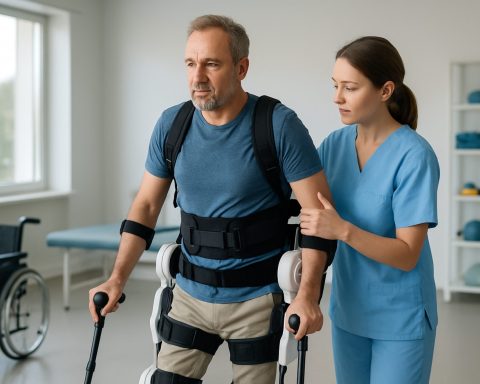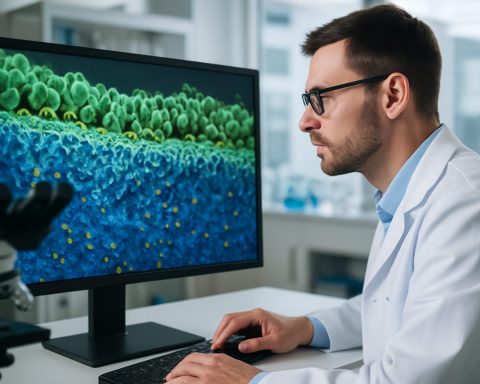How Stochastic Resonance Revolutionizes Sensory Perception: Unveiling the Science Behind Enhanced Signal Detection in Biological and Artificial Systems (2025)
- Introduction to Stochastic Resonance: Concept and Historical Milestones
- Fundamental Mechanisms: How Noise Enhances Sensory Signal Detection
- Biological Evidence: Stochastic Resonance in Human and Animal Senses
- Technological Applications: From Medical Devices to Robotics
- Case Studies: Auditory, Visual, and Tactile System Enhancements
- Experimental Methods and Measurement Techniques
- Current Challenges and Limitations in Research and Application
- Market and Public Interest Forecast: Growth Trends and Adoption Rates
- Emerging Technologies Leveraging Stochastic Resonance
- Future Outlook: Potential Breakthroughs and Interdisciplinary Opportunities
- Sources & References
Introduction to Stochastic Resonance: Concept and Historical Milestones
Stochastic resonance (SR) is a counterintuitive phenomenon in which the presence of a certain level of noise enhances the detection or transmission of weak signals in nonlinear systems. First conceptualized in the early 1980s, SR challenged the traditional view that noise is always detrimental to signal processing. The foundational work by Roberto Benzi, Alfonso Sutera, and Angelo Vulpiani in 1981 proposed that noise could play a constructive role in the periodic recurrence of ice ages, suggesting that random fluctuations could amplify weak periodic signals in the Earth’s climate system. This seminal idea was published in the journal Tellus and marked the birth of the SR concept.
The core mechanism of stochastic resonance involves a nonlinear system with a threshold, a weak periodic input signal, and an optimal level of random noise. When the noise intensity is tuned appropriately, it can help the system cross the threshold in synchrony with the weak signal, thereby making the signal detectable or enhancing its transmission. This effect is characterized by a resonance-like peak in the system’s response as a function of noise intensity.
Throughout the late 1980s and 1990s, SR was experimentally demonstrated in a variety of physical systems, including electronic circuits and lasers. However, a major milestone was the extension of SR to biological and sensory systems. In 1993, a landmark study by Douglass et al. showed that crayfish mechanoreceptors could detect subthreshold signals more effectively in the presence of optimal noise, providing the first direct evidence of SR in a living sensory system. This discovery spurred a wave of research into the role of SR in neural and sensory processing, with subsequent studies demonstrating its relevance in human tactile, auditory, and visual perception.
Today, stochastic resonance is recognized as a fundamental principle in sensory neuroscience, with implications for understanding how organisms process weak environmental cues and for developing novel sensory prosthetics and devices. The phenomenon is now studied across disciplines, including physics, biology, engineering, and medicine. Leading organizations such as the National Institutes of Health and the National Science Foundation have supported research into SR, reflecting its broad scientific significance. The historical trajectory of stochastic resonance—from a theoretical curiosity to a cornerstone of sensory system research—underscores the profound and sometimes surprising ways in which noise can facilitate information processing in complex systems.
Fundamental Mechanisms: How Noise Enhances Sensory Signal Detection
Stochastic resonance (SR) is a counterintuitive phenomenon in which the presence of a certain level of noise—traditionally considered detrimental—actually enhances the detection or transmission of weak signals in nonlinear systems. In the context of sensory systems, SR has been shown to play a fundamental role in improving the sensitivity and reliability of biological signal processing, particularly when stimuli are below the threshold of detection. This mechanism has been observed across a range of sensory modalities, including tactile, auditory, and visual systems.
The core mechanism underlying stochastic resonance involves the interplay between a weak periodic input signal and random background noise within a nonlinear system, such as a neuron or a sensory receptor. In the absence of noise, subthreshold signals may not be sufficient to trigger a response. However, when an optimal amount of noise is introduced, it can intermittently boost the signal above the threshold, allowing the system to detect or respond to stimuli that would otherwise go unnoticed. This effect is highly dependent on the noise intensity; too little noise fails to facilitate detection, while excessive noise overwhelms the signal, leading to diminished performance.
In biological sensory systems, this principle has been demonstrated experimentally. For example, studies on mechanoreceptors in the skin have shown that adding mechanical or electrical noise can enhance the ability to perceive weak tactile stimuli. Similarly, in the auditory system, the addition of acoustic noise has been found to improve the detection of faint tones, a phenomenon that has implications for hearing aid design and auditory prosthetics. The visual system also exhibits SR, where visual noise can enhance the perception of low-contrast images.
At the cellular level, stochastic resonance is facilitated by the inherent nonlinear properties of excitable membranes, such as those found in neurons. Ion channels, which govern the flow of ions across the cell membrane, exhibit threshold-like behavior. Noise-induced fluctuations in membrane potential can help subthreshold synaptic inputs reach the action potential threshold, thereby increasing the likelihood of neuronal firing in response to weak stimuli. This mechanism is thought to contribute to the remarkable sensitivity of biological sensors, allowing organisms to detect and respond to subtle environmental cues.
The study of stochastic resonance in sensory systems has not only deepened our understanding of neural coding and perception but has also inspired the development of bio-inspired sensors and devices. Research in this area is supported by leading scientific organizations such as the National Institutes of Health and the National Science Foundation, which fund investigations into the fundamental mechanisms and applications of SR in both biological and artificial systems.
Biological Evidence: Stochastic Resonance in Human and Animal Senses
Stochastic resonance (SR) is a phenomenon where the presence of a certain level of noise enhances the detection or transmission of weak signals in nonlinear systems. In biological sensory systems, SR has been extensively studied and experimentally validated, providing compelling evidence that noise can play a constructive role in perception and neural processing. This counterintuitive effect has been observed across a range of human and animal senses, including touch, hearing, vision, and balance.
One of the earliest and most robust demonstrations of SR in biology was in mechanoreception. Experiments with crayfish mechanoreceptors showed that adding external noise improved the animal’s ability to detect weak tactile stimuli. Similar effects have been observed in human somatosensory perception: subthreshold tactile stimuli, which are normally undetectable, can become perceptible when a small amount of mechanical or electrical noise is applied to the skin. This has been confirmed in studies involving both healthy individuals and patients with sensory deficits, suggesting that SR may be harnessed to enhance sensory function in clinical settings.
Auditory systems also exhibit SR. Research has shown that the addition of low-level noise can improve the detection of weak auditory signals in both animals and humans. For example, frogs and crickets have demonstrated improved signal detection in noisy environments, which is thought to aid in communication and predator avoidance. In humans, auditory SR has been explored as a potential therapeutic strategy for individuals with hearing impairments, where carefully controlled noise can enhance speech perception.
Visual perception is another domain where SR has been documented. Studies have demonstrated that the addition of visual noise can improve the detection of faint or low-contrast images in both animal models and human subjects. This effect is particularly pronounced in individuals with visual deficits, indicating that SR may have applications in vision rehabilitation.
The vestibular system, responsible for balance and spatial orientation, also benefits from SR. Experiments have shown that applying stochastic electrical noise to the vestibular apparatus can enhance balance control in both healthy subjects and those with balance disorders. This has led to the development of wearable devices that deliver controlled noise to improve postural stability.
Collectively, these findings underscore the ubiquity and functional significance of stochastic resonance in biological sensory systems. The phenomenon is now recognized as a fundamental principle in neuroscience and sensory physiology, with ongoing research supported by organizations such as the National Institutes of Health and the World Health Organization exploring its therapeutic potential for sensory rehabilitation and enhancement.
Technological Applications: From Medical Devices to Robotics
Stochastic resonance (SR) is a phenomenon in which the addition of a certain level of noise to a nonlinear system enhances the detection or transmission of weak signals. In sensory systems, this counterintuitive effect has been harnessed to improve the performance of both biological and artificial sensors, leading to a range of technological applications spanning medical devices, prosthetics, and robotics.
In the medical field, SR has been explored as a means to augment human sensory perception, particularly in populations with diminished sensory function. For example, research has demonstrated that subthreshold mechanical noise applied to the skin can enhance tactile sensitivity in elderly individuals and patients with diabetic neuropathy. This principle has been incorporated into the design of wearable devices and insoles that deliver controlled vibratory noise, thereby improving balance and reducing the risk of falls. Such innovations are being investigated and developed by leading research hospitals and rehabilitation institutes worldwide, including collaborations with organizations like the National Institutes of Health (NIH), which funds research into sensory augmentation and neuroprosthetics.
SR has also found applications in cochlear implants and hearing aids. By introducing optimized noise into the auditory pathway, these devices can improve speech perception in noisy environments, a significant challenge for users. The World Health Organization (WHO) recognizes hearing loss as a major global health issue, and advances in SR-based auditory prosthetics represent a promising avenue for enhancing quality of life for millions of individuals.
Beyond medical devices, SR principles are being integrated into robotic and artificial sensory systems. In robotics, the controlled addition of noise to tactile or proprioceptive sensors can improve the detection of weak signals, such as subtle changes in surface texture or force. This has implications for the development of more sensitive robotic grippers and manipulators, which are essential for delicate tasks in manufacturing, surgery, and service robotics. Research institutions and technology developers, including those affiliated with the Institute of Electrical and Electronics Engineers (IEEE), are actively exploring SR-inspired algorithms and hardware for next-generation robotic systems.
The ongoing translation of stochastic resonance from theoretical neuroscience to practical technology underscores its transformative potential. As understanding of SR deepens, its integration into sensory augmentation, rehabilitation, and intelligent machines is expected to expand, offering new solutions to challenges in healthcare and automation.
Case Studies: Auditory, Visual, and Tactile System Enhancements
Stochastic resonance (SR) is a phenomenon in which the addition of a certain level of noise to a nonlinear system enhances the detection or transmission of weak signals. In sensory systems, this counterintuitive effect has been demonstrated across auditory, visual, and tactile modalities, offering promising avenues for both basic neuroscience and clinical applications. Below, we examine case studies illustrating how SR has been harnessed to enhance sensory perception in these domains.
- Auditory System: In the auditory domain, SR has been shown to improve the detection of subthreshold sounds. For example, studies have demonstrated that adding low-level acoustic noise can enhance speech perception in individuals with hearing impairments. This effect is particularly relevant for cochlear implant users, where the introduction of controlled noise can improve the clarity of speech signals. Research conducted at institutions such as the National Institutes of Health has explored the neural mechanisms underlying this enhancement, suggesting that SR may facilitate the synchronization of neural firing in the auditory pathway, thereby improving signal detection.
- Visual System: In the visual system, SR has been investigated as a means to enhance contrast sensitivity and visual acuity. Experiments have shown that the addition of visual noise—such as random pixel fluctuations—can help individuals detect faint or low-contrast images more effectively. This has implications for populations with visual deficits, including the elderly and those with retinal diseases. Research supported by organizations like the National Eye Institute has provided evidence that SR can modulate the response properties of retinal and cortical neurons, leading to improved visual performance under certain conditions.
- Tactile System: The tactile modality has also benefited from SR-based interventions. For instance, the application of subthreshold mechanical vibrations to the skin has been found to enhance the ability to detect weak tactile stimuli. This approach has been explored for improving balance and proprioception in older adults and patients with neuropathy. Studies funded by the National Science Foundation have demonstrated that SR can increase the sensitivity of mechanoreceptors, thereby facilitating better sensory feedback and motor control.
These case studies collectively highlight the versatility of stochastic resonance as a tool for sensory enhancement. By leveraging the constructive role of noise, researchers and clinicians are developing novel strategies to compensate for sensory deficits and improve quality of life for affected individuals. Ongoing research continues to refine these approaches, with the goal of translating laboratory findings into practical, real-world applications.
Experimental Methods and Measurement Techniques
Experimental investigation of stochastic resonance (SR) in sensory systems requires precise methodologies to quantify how noise influences signal detection and processing. Researchers typically employ a combination of psychophysical, electrophysiological, and computational approaches to elucidate SR phenomena across various sensory modalities, including tactile, auditory, and visual systems.
In psychophysical experiments, human or animal subjects are presented with subthreshold stimuli—signals too weak to be detected under normal conditions—while controlled levels of external noise are introduced. The subject’s ability to detect or discriminate the stimulus is measured as a function of noise intensity. The hallmark of SR is an inverted-U relationship: performance improves with increasing noise up to an optimal point, then declines as noise becomes excessive. Standard measurement techniques include forced-choice paradigms, reaction time analysis, and signal detection theory metrics such as d-prime (d’), which quantifies sensitivity independently of response bias.
Electrophysiological methods provide direct insight into neural correlates of SR. In animal models, microelectrode recordings from sensory neurons or brain regions (e.g., somatosensory cortex, auditory nerve) are used to monitor action potential firing rates in response to noisy and noise-free stimuli. In humans, non-invasive techniques such as electroencephalography (EEG) and magnetoencephalography (MEG) allow researchers to assess event-related potentials (ERPs) and oscillatory activity associated with SR. These methods can reveal how noise modulates neural coding and information transfer in sensory pathways.
Advanced measurement techniques also include functional magnetic resonance imaging (fMRI) to localize brain regions involved in SR, and transcranial magnetic stimulation (TMS) to causally probe the role of cortical noise in perception. In tactile SR studies, devices such as vibrotactile actuators deliver precisely controlled mechanical noise to the skin, while in auditory SR research, calibrated acoustic noise is presented via headphones. Visual SR experiments often use computer-controlled displays to superimpose luminance or contrast noise onto visual stimuli.
Data analysis in SR research frequently involves statistical modeling to fit the characteristic SR curve and computational simulations to interpret underlying mechanisms. Researchers may employ information-theoretic measures, such as mutual information, to quantify the enhancement of signal transmission due to noise. The reproducibility and rigor of these experimental methods are supported by guidelines from organizations such as the National Institutes of Health and the World Health Organization, which promote best practices in sensory neuroscience research.
Current Challenges and Limitations in Research and Application
Stochastic resonance (SR) has emerged as a compelling phenomenon in sensory systems, where the addition of a certain level of noise can enhance the detection of weak signals. Despite its promise, several challenges and limitations continue to impede both fundamental research and practical applications in this field.
One of the primary challenges lies in the reproducibility and generalizability of SR effects across different sensory modalities and biological systems. While SR has been robustly demonstrated in controlled laboratory settings—such as in mechanoreception, auditory, and visual systems—the translation of these findings to real-world, complex environments remains problematic. Biological variability, individual differences in sensory thresholds, and the influence of adaptive neural mechanisms can all modulate or obscure SR effects, making it difficult to establish universal protocols or guidelines for leveraging SR in clinical or technological applications.
Another significant limitation is the precise control and quantification of noise. In experimental settings, noise can be carefully calibrated, but in natural or clinical environments, noise sources are often unpredictable and may interact with endogenous neural noise in non-linear ways. This complicates the optimization of noise levels required to achieve beneficial SR without inadvertently causing detrimental effects, such as sensory overload or masking of relevant signals. Furthermore, the long-term effects of repeated or chronic exposure to noise intended to induce SR are not well understood, raising concerns about safety and neural plasticity.
From a technological perspective, integrating SR principles into assistive devices—such as cochlear implants or tactile prosthetics—faces engineering and regulatory hurdles. Devices must be capable of delivering controlled, individualized noise while maintaining user comfort and safety. Additionally, regulatory bodies such as the U.S. Food and Drug Administration require rigorous evidence of efficacy and safety before approving such innovations for clinical use, which can slow the translation of SR research into practice.
Theoretical modeling of SR in complex, high-dimensional neural systems also presents ongoing challenges. Most existing models are based on simplified, low-dimensional systems, which may not capture the full dynamics of real sensory networks. This limits the predictive power of current theories and hinders the rational design of SR-based interventions. Collaborative efforts between neuroscientists, engineers, and regulatory authorities are needed to address these gaps and to develop robust, scalable, and safe applications of stochastic resonance in sensory systems.
Market and Public Interest Forecast: Growth Trends and Adoption Rates
The market and public interest in stochastic resonance (SR) applications within sensory systems are projected to experience notable growth in 2025, driven by advances in neuroscience, biomedical engineering, and wearable technology. Stochastic resonance—a phenomenon where the addition of a certain level of noise enhances the detection of weak signals in nonlinear systems—has found increasing relevance in sensory augmentation, rehabilitation, and assistive devices. This is particularly evident in fields such as prosthetics, balance aids, and neurostimulation therapies.
Academic and clinical research institutions, including those affiliated with National Institutes of Health and World Health Organization, have highlighted the potential of SR-based interventions to improve sensory perception in populations with deficits, such as the elderly or individuals with neuropathies. The growing body of peer-reviewed studies and pilot clinical trials is fostering greater confidence among healthcare providers and device manufacturers regarding the efficacy and safety of SR-enhanced technologies.
In 2025, the adoption rate of SR-based sensory systems is expected to accelerate, particularly in the domains of wearable balance aids and tactile feedback devices. Companies specializing in medical devices and rehabilitation technologies are increasingly integrating SR algorithms into their product pipelines, responding to both clinical demand and consumer interest in non-invasive, user-friendly solutions. The trend is further supported by regulatory agencies such as the U.S. Food and Drug Administration, which have begun to recognize the therapeutic potential of noise-based stimulation devices, streamlining pathways for approval and market entry.
Public interest is also on the rise, as awareness campaigns and educational initiatives by organizations like the National Institutes of Health and patient advocacy groups disseminate information about the benefits of SR in sensory rehabilitation. This has led to increased participation in clinical trials and a growing demand for accessible, at-home solutions for sensory enhancement.
Looking ahead, the market for SR in sensory systems is anticipated to expand beyond traditional healthcare settings, with potential applications in sports performance, occupational safety, and consumer electronics. The convergence of artificial intelligence, miniaturized hardware, and personalized medicine is expected to further drive innovation and adoption rates. As a result, 2025 is poised to be a pivotal year for the mainstreaming of stochastic resonance technologies, with robust growth trends and widening public engagement.
Emerging Technologies Leveraging Stochastic Resonance
Stochastic resonance (SR) is a counterintuitive phenomenon in which the presence of a certain level of noise enhances the detection or transmission of weak signals in nonlinear systems. In sensory systems, this effect has been increasingly recognized as a powerful mechanism that can be harnessed to improve human perception and the performance of artificial sensors. Recent advances in neuroscience, biomedical engineering, and robotics are driving the development of emerging technologies that leverage SR to augment sensory processing, particularly in the context of rehabilitation, prosthetics, and human-machine interfaces.
In biological sensory systems, SR has been observed in various modalities, including tactile, auditory, and visual pathways. For example, studies have shown that adding subthreshold mechanical noise to the skin can enhance tactile sensitivity in both healthy individuals and those with sensory deficits. This principle is being translated into wearable devices that deliver controlled vibratory noise to improve balance and gait in elderly populations or patients with neuropathy. Such devices exploit the SR effect to amplify weak proprioceptive signals, thereby reducing the risk of falls and improving mobility.
In the auditory domain, SR-inspired approaches are being explored to enhance speech perception in noisy environments, particularly for individuals with hearing impairments. By introducing carefully calibrated noise into hearing aids or cochlear implants, researchers aim to boost the detectability of weak auditory cues, facilitating better communication and social interaction. Similarly, visual prosthetics and brain-computer interfaces are investigating SR-based stimulation protocols to improve the perception of low-contrast or ambiguous visual stimuli.
Beyond human applications, SR is also being integrated into artificial sensory systems for robotics and autonomous vehicles. By mimicking the noise-enhanced signal detection observed in nature, engineers are designing sensors that can operate more reliably in low-signal or high-noise environments. This has implications for search-and-rescue robots, environmental monitoring, and medical diagnostics, where the ability to detect faint signals can be critical.
- The National Institutes of Health has supported research into SR-based interventions for sensory rehabilitation, highlighting the translational potential of this phenomenon.
- The National Institute on Deafness and Other Communication Disorders (a part of NIH) has funded studies on SR in auditory prosthetics.
- The National Aeronautics and Space Administration has explored SR in the context of astronaut sensorimotor function and adaptive technologies for space missions.
As research continues, the integration of stochastic resonance into sensory technologies is poised to expand, offering novel solutions for enhancing perception and performance in both clinical and technological domains.
Future Outlook: Potential Breakthroughs and Interdisciplinary Opportunities
The future of stochastic resonance (SR) in sensory systems is poised for significant breakthroughs, driven by advances in neuroscience, engineering, and computational modeling. As researchers deepen their understanding of how noise can enhance signal detection in biological and artificial systems, new interdisciplinary opportunities are emerging that could transform both clinical practice and technology development.
One promising direction is the integration of SR principles into next-generation sensory prosthetics. For example, cochlear implants and tactile feedback devices may benefit from controlled noise injection to improve sensitivity and perception in users with sensory deficits. Early-stage clinical studies have already demonstrated that subthreshold noise can enhance tactile and auditory perception in humans, suggesting that future medical devices could be designed to harness SR for improved performance. This approach aligns with ongoing research at leading institutions such as the National Institutes of Health, which supports translational neuroscience and sensory rehabilitation.
In parallel, the application of SR in artificial intelligence and robotics is gaining traction. By mimicking the noise-enhanced processing observed in biological systems, engineers are developing algorithms and sensors that exhibit greater robustness in noisy or uncertain environments. This could lead to more adaptive and resilient autonomous systems, with potential applications in healthcare, environmental monitoring, and human-machine interfaces. Organizations like the Institute of Electrical and Electronics Engineers (IEEE) are fostering interdisciplinary collaboration in this area, promoting the convergence of neuroscience, engineering, and computer science.
Looking ahead to 2025 and beyond, the convergence of SR research with fields such as nanotechnology and materials science may yield novel bio-inspired sensors capable of surpassing traditional detection limits. For instance, the development of flexible, noise-tunable materials could enable wearable devices that dynamically adjust their sensitivity based on environmental conditions or user needs. Such innovations are likely to be supported by global research initiatives, including those coordinated by the European Union, which funds interdisciplinary projects at the intersection of health, technology, and fundamental science.
Ultimately, the future outlook for stochastic resonance in sensory systems is characterized by a growing recognition of noise as a functional resource rather than a nuisance. As interdisciplinary collaborations expand and technological capabilities advance, SR is expected to play a pivotal role in shaping the next generation of sensory augmentation, intelligent systems, and biomedical devices.
Sources & References
- National Institutes of Health
- National Science Foundation
- National Institutes of Health
- World Health Organization
- Institute of Electrical and Electronics Engineers
- National Eye Institute
- National Aeronautics and Space Administration
- European Union













